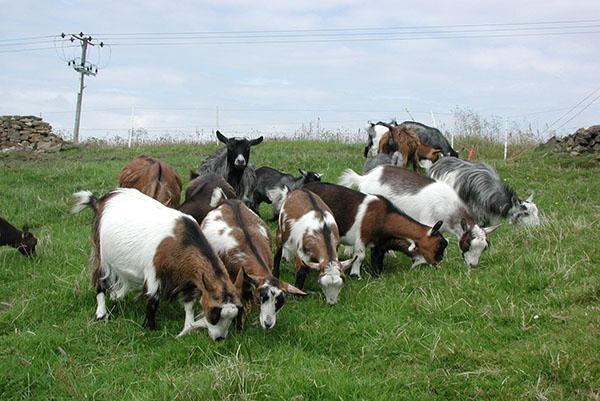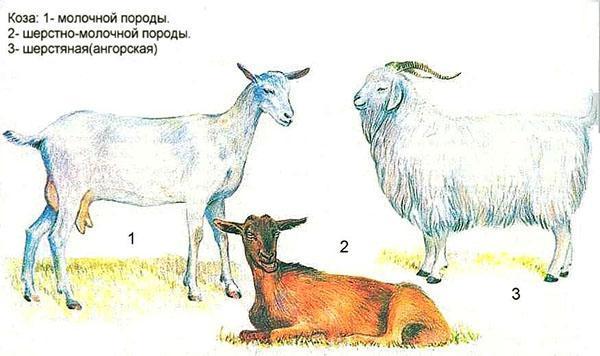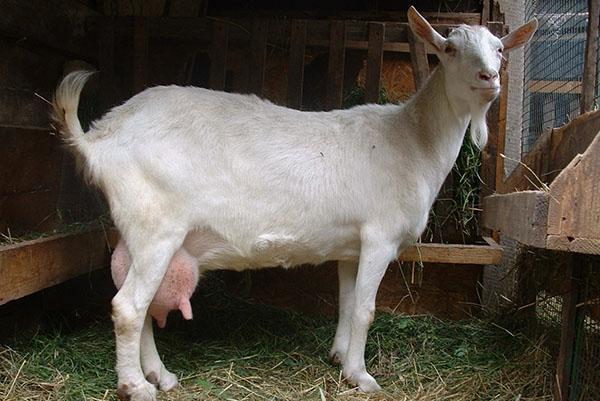Photos of goat breeds with a brief description of the characteristics
 Goats are considered one of the first animals to be domesticated by humans. The breeds of goats bred to date are dairy, meat, wool and down. There are also many intermediate varieties in the world that allow livestock breeders to achieve high productivity from the herd in two or three ways.
Goats are considered one of the first animals to be domesticated by humans. The breeds of goats bred to date are dairy, meat, wool and down. There are also many intermediate varieties in the world that allow livestock breeders to achieve high productivity from the herd in two or three ways.
The most popular among Russian owners of private farms and farms are dairy, meat and dairy and meat-wool breeds, and more than half of the total livestock is raised for the purpose of obtaining milk.

Saanen goat breed
 The European leader in popularity and productivity is rightfully considered the Zaanen breed of goats, named after the area in the Swiss Alps, where it was bred. Switzerland has become home to several famous goat breeds, which is not surprising at all. The region with a favorable climate and lush grass seems to have been created for dairy farming, but the mountainous terrain is not always suitable for grazing the main supplier of milk - cows. Therefore, fast-growing, unpretentious goats, easily climbing the most inaccessible steep slopes behind a bunch of grass, have become a godsend for many Swiss peasants.
The European leader in popularity and productivity is rightfully considered the Zaanen breed of goats, named after the area in the Swiss Alps, where it was bred. Switzerland has become home to several famous goat breeds, which is not surprising at all. The region with a favorable climate and lush grass seems to have been created for dairy farming, but the mountainous terrain is not always suitable for grazing the main supplier of milk - cows. Therefore, fast-growing, unpretentious goats, easily climbing the most inaccessible steep slopes behind a bunch of grass, have become a godsend for many Swiss peasants.
Zaanen goat breed was born as a result of folk selection. Large, 50 to 90 kg in weight, hardy animals show excellent milk production. Females are extremely fertile, and the young goatlings are strong and overwhelmingly viable. If the average weight of a baby at birth is 1.5–3 kg, then by the year a goat or goat weighs 10 times more.
During the year, an adult female gives about 650 liters of milk with a fat content of about 4%. Lactation lasts up to 300 days.
 And goats of the Zaanen breed came to Russia almost a hundred years ago. During this time, the animals have confirmed their unpretentiousness, easy adaptability to different climatic conditions and the highest milk productivity. On the basis of the best representatives of this breed of goats, numerous breed lines and new breeds have been obtained.
And goats of the Zaanen breed came to Russia almost a hundred years ago. During this time, the animals have confirmed their unpretentiousness, easy adaptability to different climatic conditions and the highest milk productivity. On the basis of the best representatives of this breed of goats, numerous breed lines and new breeds have been obtained.
However, even this species, which has long been known to people, is capable of delivering surprises. White goats of the Saanen breed sometimes have gray or brown kids. This phenomenon is associated with the manifestation of a recessive gene, which is carried by some purebred representatives. Such goats are no less productive than their white mothers, but they are not always taken into breeding.
Goat breed Toggenburg
 Another old Swiss goat breed is named after the canton of Toggenburg, where it has developed and maintained historically since the 18th century. The dairy Toggenburg goat has given rise to several European breeds over the past time. And her blood is in the livestock of Russian, British and Czech goats.
Another old Swiss goat breed is named after the canton of Toggenburg, where it has developed and maintained historically since the 18th century. The dairy Toggenburg goat has given rise to several European breeds over the past time. And her blood is in the livestock of Russian, British and Czech goats.
 If we compare animals of this breed of goats with the Zaanen goats, then the latter are much larger. The weight, for example, of the Toggenburg goat is 60 kg, and its congeners from Zaanenthal are 15–30 kg heavier. The color of goats is predominantly brown in various shades with white markings on the legs, ears and on the head.
If we compare animals of this breed of goats with the Zaanen goats, then the latter are much larger. The weight, for example, of the Toggenburg goat is 60 kg, and its congeners from Zaanenthal are 15–30 kg heavier. The color of goats is predominantly brown in various shades with white markings on the legs, ears and on the head.
The described Swiss animals belong to the odorless dairy goat breeds, which is important for obtaining not only healthy, but truly tasty products.
The Toggenburg goat breed shows decent milk production. A goat for 260 - 300 days of lactation per year can give up to 1000 liters of milk.
Russian white goat breed
 One of the most popular breeds of goats in Russia, obtained on the basis of Zaanen animals, is the Russian White. Representatives of this variety almost always have a white color, large size, excellent fertility and high milk yield. A goat is milked for up to 300 days per year, while giving up to 500 liters of milk with a fat content of up to 5%. Goats are mostly hornless. The hair of animals is short, stiff, almost devoid of undercoat.
One of the most popular breeds of goats in Russia, obtained on the basis of Zaanen animals, is the Russian White. Representatives of this variety almost always have a white color, large size, excellent fertility and high milk yield. A goat is milked for up to 300 days per year, while giving up to 500 liters of milk with a fat content of up to 5%. Goats are mostly hornless. The hair of animals is short, stiff, almost devoid of undercoat.
Anglo-Nubian goats
 The meat and dairy direction can be represented by Anglo-Nubian goats. An ancient breed historically formed on the stony deserts of Northern Sudan has been used by local residents from time immemorial as a universal and extremely unpretentious breed. The interest from the Europeans was first shown by the French and English colonialists.
The meat and dairy direction can be represented by Anglo-Nubian goats. An ancient breed historically formed on the stony deserts of Northern Sudan has been used by local residents from time immemorial as a universal and extremely unpretentious breed. The interest from the Europeans was first shown by the French and English colonialists.
Therefore, seeing a description or a photo of the Nubian goat breed, you need to know that we are obviously talking about modern Anglo-Nubian animals. As a result of crossing unpretentious African goats with productive British individuals, a new variety was obtained. Anglo-Nubian goats have an unusual appearance, large size and interesting meat and dairy data.
Hump-nosed females with hanging ears can grow up to 80 kg, and the same large males can grow up to 130 kg. The growth of an adult goat often reaches 90 cm at the withers.
 Animals are unpretentious to the type and composition of feed, while giving up to 800 liters of very fat milk per year. Raw materials suitable for drinking and making lactic acid, curd and cheese products contain up to 8% fat.
Animals are unpretentious to the type and composition of feed, while giving up to 800 liters of very fat milk per year. Raw materials suitable for drinking and making lactic acid, curd and cheese products contain up to 8% fat.
Cameroon dwarf goats
 Small goats from Cameroon have become widespread not only in their homeland, but also in a number of European countries due to their modest size, record simplicity and decent quality of milk and meat. According to the legend, dwarf goats came to the Old World on the ships of fishermen and pirates. The animals were so capricious that they easily endured many months of voyages, moreover, supplying the crew with milk and fresh meat.
Small goats from Cameroon have become widespread not only in their homeland, but also in a number of European countries due to their modest size, record simplicity and decent quality of milk and meat. According to the legend, dwarf goats came to the Old World on the ships of fishermen and pirates. The animals were so capricious that they easily endured many months of voyages, moreover, supplying the crew with milk and fresh meat.
Today, the popularity of animals is supported by the fact that it is an odorless breed of dairy goats. The meat of goats of this breed does not have an unpleasant aftertaste.
Alpine goat breed
 Historically, the Alpine regions of European countries have developed their own varieties of dairy and meat and dairy goats. All these animals are distinguished by their quick adaptation to new conditions, unpretentiousness, high productivity and gracefulness characteristic of rocks. At the beginning of the last century, American breeders set themselves the goal of obtaining a goat breed that combines all the positive aspects of the Alpine population of domestic goats.
Historically, the Alpine regions of European countries have developed their own varieties of dairy and meat and dairy goats. All these animals are distinguished by their quick adaptation to new conditions, unpretentiousness, high productivity and gracefulness characteristic of rocks. At the beginning of the last century, American breeders set themselves the goal of obtaining a goat breed that combines all the positive aspects of the Alpine population of domestic goats.
According to the photos and descriptions of the Alpine goat breed, animals from Switzerland, France, Italy and other countries of the continent took part in its formation. As a result, the goats received an extensive set of genes, expressed, for example, in the variegated coloration of babies born to Alpine goats.
Boer goats
 Today, goats are raised not only for milk and wool, but for meat. Such breeds are easily recognizable by their developed muscles, stronger bones. An example is the Boer goats, which were exported from southern Africa about a hundred years ago.
Today, goats are raised not only for milk and wool, but for meat. Such breeds are easily recognizable by their developed muscles, stronger bones. An example is the Boer goats, which were exported from southern Africa about a hundred years ago.
The weight of an adult goat of this breed reaches 130 kg, the female is 30–35 kg lighter. In appearance, the Boer breed has many similarities with another African species - the Anglo-Nubian goats.
Modern Boer goats are early maturing, characterized by high growth rate and endurance. They rarely get sick and, most importantly, have extremely tasty meat, without the slightest sign of a characteristic smell.
Brown Czech goats
 The history of the Czech goat breed goes back about a century, although it was given official status only in the 70s of the last century. Producers of the best alpine varieties took part in the creation of Czech goats. The result of breeding work exceeded all expectations. Animals of this picky, hardy breed of goats quickly change from one diet to another, can stay in the pasture for a long time and easily tolerate long hikes in mountainous terrain.
The history of the Czech goat breed goes back about a century, although it was given official status only in the 70s of the last century. Producers of the best alpine varieties took part in the creation of Czech goats. The result of breeding work exceeded all expectations. Animals of this picky, hardy breed of goats quickly change from one diet to another, can stay in the pasture for a long time and easily tolerate long hikes in mountainous terrain.
 The Czech goat reaches a weight of 50 kg, males are one and a half times heavier. The milk yield of such a goat reaches 800 liters per year. At the same time, milk does not have an unpleasant odor or taste, and with a fat content of about 3.5% it has a thick consistency and a high lactose content.
The Czech goat reaches a weight of 50 kg, males are one and a half times heavier. The milk yield of such a goat reaches 800 liters per year. At the same time, milk does not have an unpleasant odor or taste, and with a fat content of about 3.5% it has a thick consistency and a high lactose content.
Angora goats
 Although the Angora goats are considered one of the smallest members of the genus, they are valued on a par with other popular varieties. This ancient breed is native to the Middle East, Turkey and Kurdistan. The animals, accustomed to the sharply changing mountain climate, are covered with thin long hair with wavy hair. The weight of an adult, depending on gender, ranges from 35 to 55 kg. Both goats and goats have horns.
Although the Angora goats are considered one of the smallest members of the genus, they are valued on a par with other popular varieties. This ancient breed is native to the Middle East, Turkey and Kurdistan. The animals, accustomed to the sharply changing mountain climate, are covered with thin long hair with wavy hair. The weight of an adult, depending on gender, ranges from 35 to 55 kg. Both goats and goats have horns.
Wool is renowned for its luster, fiber strength and quality. The main color of this breed of goats is white. Such wool is the most valuable, although you can see gray and even black angora goats.
tell me what the mixture is
Alpine
tell me what kind of breed! Thank!
I'm not entirely sure of the correct answer, because to determine the breed you need to take a closer look at the animal. It looks like an Alpine goat, but most likely not purebred.
here's another photo
I would like to buy a mini goat and a kid, dairy breed, odorless
Tell me what kind of breed is a white goat and a white goat with a curly forelock between the horns?
How accurately can you find out the breed of a goat from the descriptions? Is it possible that the breed itself is degenerating?
Is there a "Kineas" breed?
No, there is no such breed of goat yet. Breed degeneration occurs when goats of different breeds are chaotic mating. It's like mongrel dogs. They may be cute, but lack clear signs of a particular breed.
Can't identify the breed, help.
To determine the breed of an animal, one photo from above is not enough.
Tell me what kind of breed?
To accurately determine the breed of goats, you need not just a photograph of them, but accurate size data (height, body length, udder size, and others). Besides this photo is not very good. animals are photographed when they are standing so that the profile is clearly visible.